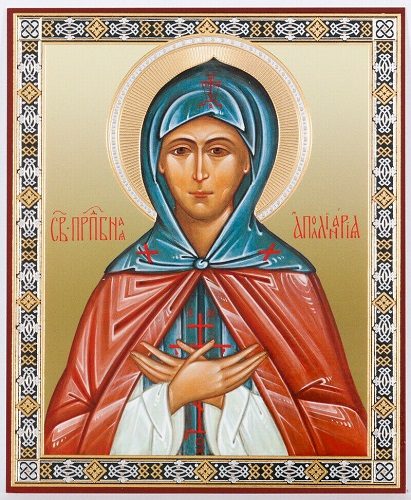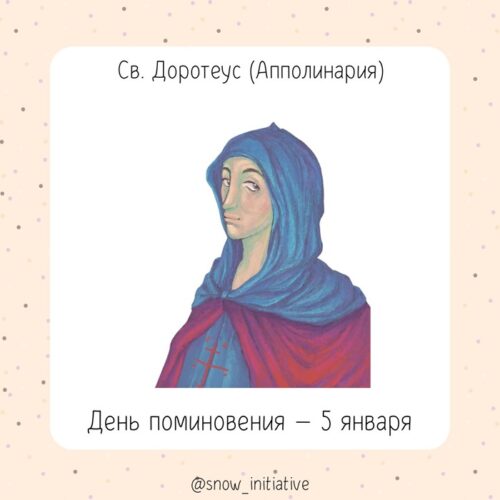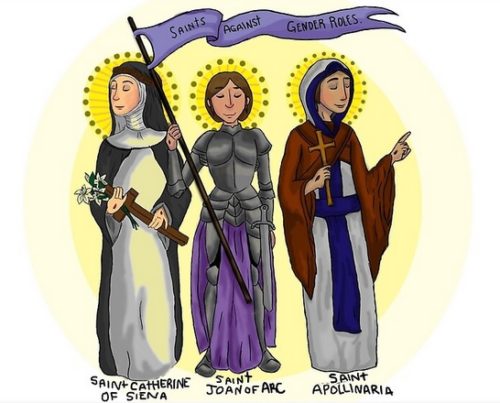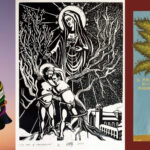Last Updated on January 28, 2025 by Kittredge Cherry

Saint Apollinaria of Egypt or Dorotheos has been called a transgender icon or a cross-dressing saint. Assigned female at birth, Apollinaria adopted the name Dorotheos and entered a monastery as a man in fifth-century Egypt. This saint is honored by churches on Jan. 5-6 and can be an inspiration for LGBTQ people, who sometimes call themselves “friends of Dorothy” (based on gay connections to Dorothy in “The Wizard of Oz.”)
Dorotheos’ father learned the secret when he accused the monk of getting his other daughter pregnant. Otherwise Dorotheos lived as a monk until death, when the full story became public.
Apollinaria / Dorotheos is sometimes called Apollinaris Syncletica of Alexandria. The story of Apollinaria / Dorotheos is similar to more than 20 queer saints who are venerated as women who cross-dressed in order to serve God and avoid marriage. An overview of them is presented in “Trans Saints? Early cross-dressing monks and martyrs.”
Mixed emotions show on the face of the saint in an icon created by Snow Initiative (Инициатива СНеГ), a group by and for nonbinary people, based in St. Petersburg, Russia.

“St. Dorotheos (Apollinaria), Day of Remembrance January 5” by the nonbinary Russian group Snow Initiative
Q Spirit is pleased to share the following profile of Apollinaria / Dorotheos by Terence Weldon, a gay Catholic expert on queer saints. Language for describing transgender experience is changing quickly. This article maintains all of Weldon’s original wording, even though some vocabulary already seems outdated.
Apollinaria / Dorotheos
By Terence Weldon
(Reposted from Queering the Church with permission)
According to the LGBT Catholic Handbook, this week sees the feast day of St. Apollinaria /Dorotheos of Egypt (5th, 6th January). She is said to have been one of a group of transvestite saints – women who took on men’s clothing in order to live as monks.
For the specific story of Apollinaria, we turn to the Orthodox church, who take these female monks rather more seriously than the western church.
This is from the Orthodox website, “God is Wonderful in His Saints”
She was a maiden of high rank, the daughter of a magistrate named Anthimus in the city of Rome. Filled with love for Christ, she prevailed on her parents to allow her to travel on pilgrimage to the Holy Land. In Jerusalem she dismissed most of her attendants, gave her jewels, fine clothes and money to the poor, and went on to Egypt accompanied only by two trusted servants. Near Alexandria she slipped away from them and fled to a forest, where she lived in ascesis for many years. She then made her way to Sketis, the famous desert monastic colony, and presented herself as a eunuch named Dorotheos. In this guise she was accepted as a monk.
Anthimus, having lost his elder daughter, was visited with another grief: his younger daughter was afflicted by a demon. He sent this daughter to Sketis, asking the holy fathers there to aid her by their prayers. They put her under the care of “Dorotheos”, who after days of constant prayer effected the complete cure of her (unknowing) sister. When the girl got back home it was discovered that she was pregnant, and Anthimus angrily ordered that the monk who had cared for her be sent to him. He was astonished to find that “Dorotheos” was his own daughter Apollinaria, whom he had abandoned hope of seeing again. After some days the holy woman returned to Sketis, still keeping her identity secret from her fellow-monks. Only at her death was her true story discovered.

Apollinaria, right, carries a banner proclaiming, “Saints Against Gender Roles,” along with Catherine of Siena and Joan of Arc in an image that is available on many products from Stargirllily at Redbubble.
The Handbook lists some scholarly references in support, while a look at some orthodox websites corroborates the story and confirms her feast on 5th January. The Advent Catholic Encyclopedia, however, dismisses the tale as ‘hagiographic fiction.’
Apollinaria’s story and motives are remote from our time, and ‘transvestite’ is not to be confused with ‘transgendered’. (UPDATE: After I first described this group of women as “transvestite”, I was taken to task by a reader, who pointed out that these days, “cross-dressing” is more appropriate terminology). Still, whatever the full historic truth of Apollinaria/ Dorotheos specifically, it seems to me this is a useful story to hold on to as a reminder of the important place of the transgendered, and differently gendered, in our midst. (Editor’s note: As of 2020, “transgender” is much preferred over “transgendered” which has come to be considered offensive.)
Many of us will remember how difficult and challenging was the process of recognising, and then confronting, our identities as lesbian or gay, particularly in the context of a hostile church. However difficult and challenging we may have found the process of honestly confronting our sexual identities, consider how much more challenging must be the process of confronting and negotiating honestly a full gender identity crisis.
Let us acknowledge the courage of those who have done it, and pray for those who are preparing to do so.
___
 Terence Weldon is an openly gay Catholic who blogged at Queering the Church. Originally from South Africa, he is a partnered father and grandfather based in the United Kingdom.
Terence Weldon is an openly gay Catholic who blogged at Queering the Church. Originally from South Africa, he is a partnered father and grandfather based in the United Kingdom.
Related books
“Passionate Holiness: Marginalized Christian Devotions for Distinctive People” by Dennis O’Neill
 Medieval society was fascinated by female-to-male cross-dressing. “Clothes Make the Man: Female Cross Dressing in Medieval Europe” by Valerie R. Hotchkiss has a wonderful “Hagiographic Appendix” with short bios of no less than 34 “transvestite saints.” All of them involve some form of cross-dressing to serve God, protect their virginity or avoid marriage.
Medieval society was fascinated by female-to-male cross-dressing. “Clothes Make the Man: Female Cross Dressing in Medieval Europe” by Valerie R. Hotchkiss has a wonderful “Hagiographic Appendix” with short bios of no less than 34 “transvestite saints.” All of them involve some form of cross-dressing to serve God, protect their virginity or avoid marriage.
___
Top image credit:
Saint Apollinaria icon from the RussianTsar Etsy shop
___
This post is part of the LGBTQ Saints series by Kittredge Cherry. Traditional and alternative saints, people in the Bible, LGBT and queer martyrs, authors, theologians, religious leaders, artists, deities and other figures of special interest to lesbian, gay, bisexual and transgender and queer (LGBTQ) people and our allies are covered.
This article was originally published on Q Spirit in February 2020, was expanded with new material over time, and was most recently updated on Jan. 28, 2025.






















There were many women saints that hid in monasteries from a prospective marriage. She wished to remain a virgin because Christ was her Bridegroom. NOT because she was transgender! Many Christians had no choice in marriage and were often persecuted and tortured for their beliefs. Imagine the disrespect you would feel if someone took your beliefs and turned them into something they were not! Have you actually read about her life? Or just heard she dressed as a man?
Entering a monastery disguised as a man does not make her “transgender” any more than a woman who disguises herself for protection would qualify as transgender.
LGBTQ the people are not psycho. They believe the way they do and we should not judge them, just as they should not judge others. Please remember brothers and sisters, “Judge not, lest yee be judged” I consider myself a true believer in our church. I hope one-day people will come to the true meaning of Jesus.